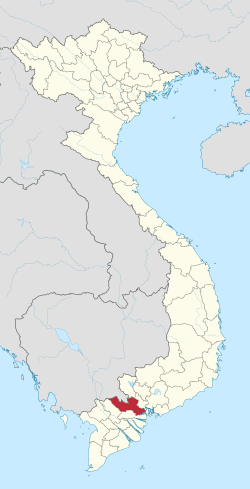Long An province
Province of Vietnam From Wikipedia, the free encyclopedia
Province of Vietnam From Wikipedia, the free encyclopedia
Long An is a province in the Mekong Delta region of southern Vietnam. The provincial capital is Tân An city, and other major districts and town include Kiến Tường, Bến Lức, Cần Giuộc and Đức Hòa. There are 15 districts within the province (included 1 provincial capital city and 1 district-level town).[5]
Long An | |
|---|---|
 Downtown of Tân An city with Bảo Định river | |
 Location of Long An within Vietnam | |
 | |
| Coordinates: 10°40′N 106°10′E | |
| Country | |
| Region | Mekong Delta |
| Metropolitan area | Ho Chi Minh City metropolitan area |
| Capital | Tân An |
| Government | |
| • People's Council Chair | Trương Văn Tiếp |
| • People's Committee Chair | Dương Quốc Xuân |
| Area | |
| • Total | 4,494.79 km2 (1,735.45 sq mi) |
| Population (2023)[2] | |
| • Total | 1,743,400 |
| • Density | 390/km2 (1,000/sq mi) |
| Demographics | |
| • Ethnicities | Vietnamese, Hoa, Khmer |
| GDP[3] | |
| • Total | VND 168.108 trillion US$ 7.053 billion (2023) |
| Time zone | UTC+7 (ICT) |
| Calling code | 72 |
| ISO 3166 code | VN-41 |
| HDI (2020) | (27th) |
| Website | eng |

The region is between Ho Chi Minh City and Southeast region in the north and the Mekong Delta. Because of its low lying geography, it is susceptible to sea level rise caused by climate change.
Long An is situated in an advantageous position in the Southern Key Economic Region of Vietnam. It serves as a bridge between Ho Chi Minh City in the north and 12 provinces in the Mekong Delta in the south. The province also has Cambodia to its west and the East Sea (South China Sea) to its east.
Long An is a low-lying coastal region, and therefore some areas of it are subject to flooding during the rainy season, which lasts from the beginning of August until November.
The province has numerous rivers. Two of the main ones are the Vàm Cỏ Đông and Vàm Cỏ Tay, which connect with the Tiền to form a larger river system. Another important river in the region is the Soài Rạp.
Archaeological sites show that, since ancient times, Long An has been an important territory of the Funan-Zhenla kingdom.[6] When Nguyễn Hữu Cảnh came to explore the South, Long An belonged to Gia Định prefecture. During the reign of Minh Mạng, Long An belonged to Gia Định province and partly to Định Tường province. In the early days of French colonization, Nam Kỳ was divided into 21 provinces, and Long An was located within the two provinces of Tân An and Chợ Lớn.[6]
Long An is subdivided into 15 district-level sub-divisions:
They are further subdivided into 14 commune-level towns (or townlets), 166 communes, and 12 wards.
On Vietnam's Provincial Competitiveness Index 2023, a key tool for evaluating the business environment in Vietnam’s provinces, Long An received a score of 70.94. This was an improvement from 2022 in which the province received a score of 68.45. In 2023, the province received its highest scores on the 'Law & Order' and 'Informal Charges' criterion and lowest on 'Business Support Policy' and 'Access To Land'.[7]
Being a low-lying coastal region, Long An is particularly susceptible to floods resulting from rises in sea level due to climate change. The Climate Change Research Institute at Can Tho University (Trường Đại học Cần Thơ), in studying the possible consequences of climate change, has predicted that 49% of Long An province is expected to be flooded if sea levels rise by one meter.[8]
Long An is home to two large universities:
136C ĐT827, P7, Tân An, Long An 82100, Vietnam
Seamless Wikipedia browsing. On steroids.
Every time you click a link to Wikipedia, Wiktionary or Wikiquote in your browser's search results, it will show the modern Wikiwand interface.
Wikiwand extension is a five stars, simple, with minimum permission required to keep your browsing private, safe and transparent.